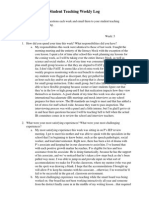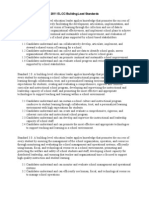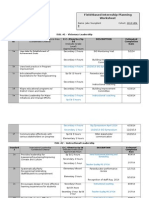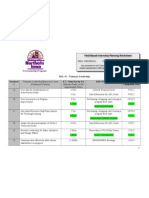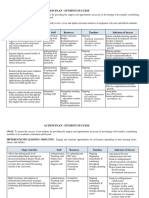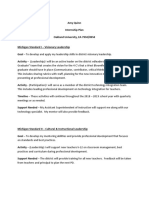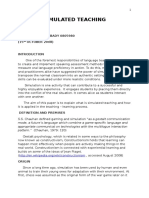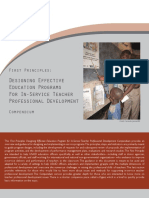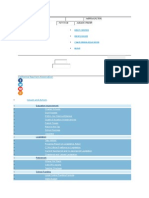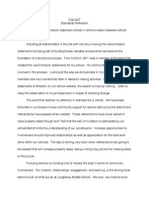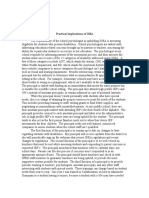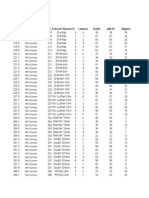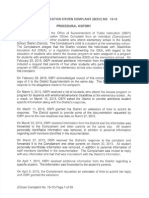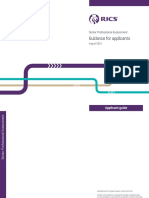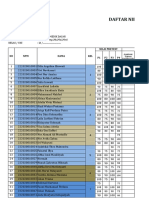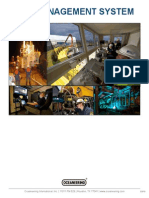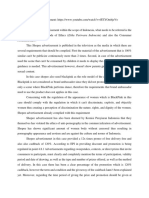Danielson Facilitators Guide
Danielson Facilitators Guide
Uploaded by
Julian A.Copyright:
Available Formats
Danielson Facilitators Guide
Danielson Facilitators Guide
Uploaded by
Julian A.Copyright
Available Formats
Share this document
Did you find this document useful?
Is this content inappropriate?
Copyright:
Available Formats
Danielson Facilitators Guide
Danielson Facilitators Guide
Uploaded by
Julian A.Copyright:
Available Formats
September DLT - Danielson Calibration 9:15am 11:45am Facilitated in levels by the TIF Team Out comes: Revisit the
he Danielson PD focus for the year and alignment to SPS goals: Pillar 1: Great principals who are highly skilled instructional leaders. Pillar 2: Great teachers who are highly skilled in meeting the needs of all students. Share best practices in developing a growth mindset throughout the district. Expand knowledge of the effective use of the Danielson framework. Become more calibrated by focusing on evidence collection (both the how and the what). Begin to write claims that are justified by sufficient evidence.
Agenda: Time 9:15 9:20 What Set the Stage Slides 1-4 How Review agenda, outcomes, norms Parking lot close loop on questions from SLI (in written memo) & open new lot Housekeeping 9:20 9:40 Check in/Best Practice Sharing 5-6 Leaders share copies of artifacts in small groups Quick demo of PG&E school leaders website If leaders are comfortable handing in their artifacts to put on the website, make sure they write their name and school name on the front. Please collect them and give them to Jen at the end of the day. Not all pieces will be added to the site. We will If there is time, highlight 1-2 useful artifacts to the entire group. Facilitator Notes Develop heterogeneous groups based on instructional expertise. Assume nobody is going to attend the Educational Impact session and adjust accordingly before you begin. Put a star by the facilitators name in each group.
9:40- 10:15
Anchor Reading
Read Chapter 2 of Mindset Discussion protocol
avoid duplicates. We dont plan to read the entire Mindset book. Chapter 2 will be it. The next reading will focus on HOW we change mindsets. Allow people 15 minutes to skim the reading so those who didnt read it can catch up. Ask them to underline the parts of the text that they aspire to. SLI Calibration Data Slides: Use the slides to discuss the why behind the calibration work. Framework Slide: Point out the previous learnings, including the pivotal components, observable domains and the heart of the framework Common Practice Slide: Share that today we will focus on evidence collection both the how and the what If you are behind, you could skip the share out and just have them note look fors as they read If you are running behind, simply summarize this section and move on to the formative assessment Explain that there isnt one type of note-taking template that works best for all. Use what works for you to collect evidence quickly and accurately. In Thumbs up Thumbs Down: Note that the last one is tricky because the word most isnt quantifiable and the word engaged can be subjective Watch the first 8.5 minutes of the clip Explain that all levels are watching the same clip so
10:15 10:20
Linking to SLI
8-12
Direct instruction reviewing some of the material from SLI
10:20 10:30
10:30 10:40
Preparing for the Observation Descriptive Note-taking
13
Read Domain 3 and note/discuss look fors
14-18
Direct instruction describing how to collect appropriate and sufficient evidence Hand out note-taking template Ask participants to read Why be descriptive on their own. Formative assessment during Thumbs Up/Thumbs Down Video Ms. Givens
10:40 10:50
Video
19
10:50 11:00
Calibration Data
20
Leaders rate the lesson for all components within Domain 3 on a post-it note
we can gather data on how calibrated we are K-12 If there is time at the end of the session, tally these and share them out to the group. Explain that we will share this data for all principals K-12 at the next DLT session.
11:00 11:10
Gather Evidence
21
Leaders code their evidence by component in Domain 3 by writing in the margin of their notes Table groups decide on their focus component (the component in which they all gathered the most evidence) Whole group share out Share a model of the completed chart On the left side they will note the elements within their focus component. They will align their evidence to these elements. If they collected five pieces of evidence for an element, they can write a claim. If they dont have five pieces of evidence, they will write look fors (things they will look for in their next observation or conversation with the teacher to continue collecting evidence) Before they begin working, go through slides 2324 to describe the characteristics of a strong claim Ask 2 groups to share out Colleagues provide feedback using the guiding questions in the PowerPoint Take 2-3 comments to wrap things up
11:10 11:30
Breaking down the evidence
22 -24
Have groups start with the element they collected the most evidence for and try to push all groups to write at least one claim. Note: They will not be able to complete the activity for all elements within their focus component.
11:30 11:40
Whole Group Share Out
25
In the share out, push groups to consider if the evidence that is collected is sufficient and appropriate If these arent mentioned, highlight the following take-aways:
11:40 11:45
Final TakeAways
26
Remind people to attend the optional Ed Impact session at lunch
We will become more closely calibrated and more proficient in the framework when we root our discussions in concrete evidence Evidence should be non-judgmental Sufficient evidence (at least five pieces) is needed before making a claim.
You might also like
- Signature Assignment Edl622Document12 pagesSignature Assignment Edl622api-418534829No ratings yet
- On Becoming An Ethical Leader - FinalDocument8 pagesOn Becoming An Ethical Leader - Finalapi-510869532No ratings yet
- Leading with Administrator Clarity: School-Wide Strategies for Cultivating Communication, Fostering a Responsive Culture, and Inspiring Intentional LeadershipFrom EverandLeading with Administrator Clarity: School-Wide Strategies for Cultivating Communication, Fostering a Responsive Culture, and Inspiring Intentional LeadershipNo ratings yet
- Student Teaching Weekly Reflection 1Document2 pagesStudent Teaching Weekly Reflection 1Megan CrossettNo ratings yet
- Cuin 4375 - CMP FinalDocument31 pagesCuin 4375 - CMP Finalapi-528913130No ratings yet
- Principal Leadership StyleDocument99 pagesPrincipal Leadership StyleFrankPeart100% (2)
- ELCC Building Level 2011 SummaryDocument3 pagesELCC Building Level 2011 Summarymrallen01No ratings yet
- Drapinski Final Educational Philosophy 2Document5 pagesDrapinski Final Educational Philosophy 2api-237844266No ratings yet
- 2013 FfTEvalInstrument Web v1.2 20140825 PDFDocument111 pages2013 FfTEvalInstrument Web v1.2 20140825 PDFBasem Abdelrahman100% (1)
- IIMDocument39 pagesIIMRaunaq AroraNo ratings yet
- Applied Research Assignment-AbsenteesimDocument14 pagesApplied Research Assignment-AbsenteesimPatrick ntupiNo ratings yet
- Personal Leadership Platform Paper - Website AppropriateDocument12 pagesPersonal Leadership Platform Paper - Website Appropriateapi-340850478No ratings yet
- Field-Based Internship Planning WorksheetDocument7 pagesField-Based Internship Planning Worksheetapi-277941915No ratings yet
- Liceo de Cagayan University Senior High School - RNP Campu SDocument36 pagesLiceo de Cagayan University Senior High School - RNP Campu SKRYZL JANE BALABAGNo ratings yet
- School Culture AuditDocument5 pagesSchool Culture Auditapi-322957230100% (1)
- Exemplary Leadership EssayDocument8 pagesExemplary Leadership Essayapi-312386916100% (1)
- The Use of Value-Added Measures of Teacher Effectiveness in Policy and PracticeDocument46 pagesThe Use of Value-Added Measures of Teacher Effectiveness in Policy and PracticeGothamSchools.orgNo ratings yet
- Field - Based Internship Planning WorksheetDocument6 pagesField - Based Internship Planning Worksheetapi-206214367No ratings yet
- Student Success Action Plan Aug 2015Document13 pagesStudent Success Action Plan Aug 2015Rienalyn GalsimNo ratings yet
- Portfolio School of Education Professional DispositionsDocument4 pagesPortfolio School of Education Professional Dispositionsapi-554373722No ratings yet
- Idaho Core Teacher Standards and The Danielson FrameworkDocument22 pagesIdaho Core Teacher Standards and The Danielson Frameworkapi-530048614No ratings yet
- FY 2023 Superintendent's Proposed Budget 1.20.2022Document42 pagesFY 2023 Superintendent's Proposed Budget 1.20.2022Fauquier NowNo ratings yet
- Internship Plan - Amy Quinn UpdatedDocument4 pagesInternship Plan - Amy Quinn Updatedapi-283622630No ratings yet
- Advocacy PlanDocument4 pagesAdvocacy Planapi-251254104No ratings yet
- Marshall Fbla Interview PaperDocument8 pagesMarshall Fbla Interview Paperapi-319740475No ratings yet
- School Climate Conducing To LearningDocument10 pagesSchool Climate Conducing To LearningPakNo ratings yet
- Anne Franklin ResumeDocument3 pagesAnne Franklin Resumeapi-199312646No ratings yet
- RCSD Proposed Budget 2022-23'Document269 pagesRCSD Proposed Budget 2022-23'Panos ArgitisNo ratings yet
- Buck Personal Vision Essay FinalDocument12 pagesBuck Personal Vision Essay Finalapi-240893450No ratings yet
- Action Plan Full ProjectDocument16 pagesAction Plan Full Projectapi-437407548100% (1)
- Tom InternshipplanDocument3 pagesTom Internshipplanapi-277190928No ratings yet
- Open Enrollment Policy Final SFSDDocument13 pagesOpen Enrollment Policy Final SFSDShellyNo ratings yet
- Simulated TeachingDocument6 pagesSimulated TeachingrinkuNo ratings yet
- Designing Effective PDDocument36 pagesDesigning Effective PDaspiredNo ratings yet
- Chouinard EER504 Assignment 2 FinalDocument11 pagesChouinard EER504 Assignment 2 Finaljchoui01No ratings yet
- Mases Final Acs-Wasc 2Document117 pagesMases Final Acs-Wasc 2api-242315971No ratings yet
- Leadership Platform PaperDocument7 pagesLeadership Platform Paperapi-469314892No ratings yet
- Developing The Conditions For Data Driven Change To Impact Student Achievement and Build Teacher CapacityDocument19 pagesDeveloping The Conditions For Data Driven Change To Impact Student Achievement and Build Teacher CapacityGlobal Research and Development ServicesNo ratings yet
- Atlanta Public Schools - Equity Audit Report FinalDocument97 pagesAtlanta Public Schools - Equity Audit Report FinalmaxblauNo ratings yet
- Activity 3 Educational LeadershipDocument7 pagesActivity 3 Educational LeadershipRaymart NaagNo ratings yet
- Leadership Platform - JonesDocument7 pagesLeadership Platform - Jonesapi-132081358No ratings yet
- Project EDU820Document8 pagesProject EDU820David OwoseniNo ratings yet
- Practicum Plan and Campus-Supervised Log1Document15 pagesPracticum Plan and Campus-Supervised Log1api-251400390No ratings yet
- From TOP Down To BOTTOM Up!Document7 pagesFrom TOP Down To BOTTOM Up!jb_uspuNo ratings yet
- My Reflection Domain 3 InstructionDocument8 pagesMy Reflection Domain 3 Instructionapi-268819257No ratings yet
- 14 15 School Improvement PlanDocument101 pages14 15 School Improvement Planapi-233925555No ratings yet
- Summary Book 2021Document66 pagesSummary Book 2021Joshua MoralesNo ratings yet
- Clinical Eval 4 2Document13 pagesClinical Eval 4 2api-394113201No ratings yet
- Personal Leadership PlatformDocument8 pagesPersonal Leadership Platformapi-500044547No ratings yet
- Leadership PlatformDocument6 pagesLeadership Platformapi-518487521100% (1)
- Ramos Daniel Ead 523 School PD AnalysisDocument6 pagesRamos Daniel Ead 523 School PD Analysisapi-538254008No ratings yet
- Identifying and Empowering Instructional LeadersDocument6 pagesIdentifying and Empowering Instructional Leadersapi-628625061No ratings yet
- Q W Learning Walk LetterDocument2 pagesQ W Learning Walk LetterChip ChaseNo ratings yet
- Running Head: Field Experience C: Leader Activity 1Document4 pagesRunning Head: Field Experience C: Leader Activity 1Jillian IliseNo ratings yet
- 637 Reflection PaperDocument7 pages637 Reflection Paperapi-275139555No ratings yet
- Framework For Data-Driven Learning PDFDocument22 pagesFramework For Data-Driven Learning PDFPadmaja SurenNo ratings yet
- Field Experience C - Practical Implications of Idea DardenDocument3 pagesField Experience C - Practical Implications of Idea Dardenapi-515615857No ratings yet
- Principal InterviewDocument3 pagesPrincipal Interviewapi-530746000No ratings yet
- Personal Leadership PlatformDocument8 pagesPersonal Leadership Platformapi-516897718No ratings yet
- Exemplary Classroom Questioning: Practices to Promote Thinking and LearningFrom EverandExemplary Classroom Questioning: Practices to Promote Thinking and LearningRating: 5 out of 5 stars5/5 (1)
- Final ELL Staffing For 10-12-2015 Updated at 2 10pmDocument12 pagesFinal ELL Staffing For 10-12-2015 Updated at 2 10pmJulian A.No ratings yet
- Schoolid Equity Factor NBR % of Below Grade Level StudentsDocument5 pagesSchoolid Equity Factor NBR % of Below Grade Level StudentsJulian A.No ratings yet
- Seattle Schools Staffing Adjustment Appendix 2015Document6 pagesSeattle Schools Staffing Adjustment Appendix 2015westello7136No ratings yet
- Brent Kroon Interim Director, Enrollment Planning Seattle Public Schools (206) 252-0747Document2 pagesBrent Kroon Interim Director, Enrollment Planning Seattle Public Schools (206) 252-0747Julian A.No ratings yet
- Teacher FTE IA FTEDocument45 pagesTeacher FTE IA FTEJulian A.No ratings yet
- February Enrollment NumbersDocument70 pagesFebruary Enrollment NumbersJulian A.No ratings yet
- Seattle SBAC Resolution Board Action Report Doc DRAFT Revision 5.0Document3 pagesSeattle SBAC Resolution Board Action Report Doc DRAFT Revision 5.0Julian A.No ratings yet
- Allschlsalloc enrollFY2016Document291 pagesAllschlsalloc enrollFY2016Julian A.No ratings yet
- SEAAC Financial Accountability Position PaperDocument143 pagesSEAAC Financial Accountability Position PaperJulian A.No ratings yet
- Compliance That We Care About: Executive Summary: This Page Is Intentionally Blank in This DraftDocument9 pagesCompliance That We Care About: Executive Summary: This Page Is Intentionally Blank in This DraftJulian A.No ratings yet
- SEAACPosition Paper Risers FinalDocument8 pagesSEAACPosition Paper Risers FinalJulian A.No ratings yet
- Seattle Schools Special Education - OSPI Citizens ComplaintDocument30 pagesSeattle Schools Special Education - OSPI Citizens Complaintwestello7136100% (1)
- Rics Spa Applicants Guide enDocument12 pagesRics Spa Applicants Guide enmhamrawyNo ratings yet
- Daftar Nilai Ilmu Biomedik Dasar 3 Sem 2Document28 pagesDaftar Nilai Ilmu Biomedik Dasar 3 Sem 2novy kumalasariNo ratings yet
- Internal 1 2011 14 - 0Document2 pagesInternal 1 2011 14 - 0Sudeep SharmaNo ratings yet
- Breaking Generational CursesDocument20 pagesBreaking Generational Cursesapi-231781675No ratings yet
- OrnamentDocument172 pagesOrnamenthulpeNo ratings yet
- HSE Management SystemsDocument20 pagesHSE Management SystemsGun Kuntara Adhiarta100% (2)
- Pioneers of SociologyDocument2 pagesPioneers of SociologycleonefontaineNo ratings yet
- Full Mindart Full Body Empty Mind Will Johnson MeditationDocument4 pagesFull Mindart Full Body Empty Mind Will Johnson Meditationtruthforme0% (1)
- National StereotypesDocument3 pagesNational StereotypesАнастасия ЗбирняNo ratings yet
- Consumer Perception: Consumer Behavior, Eighth Edition Schiffman & KanukDocument41 pagesConsumer Perception: Consumer Behavior, Eighth Edition Schiffman & KanukisotopeneoNo ratings yet
- HRD in Global PerspectiveDocument16 pagesHRD in Global PerspectiveHarsimran SinghNo ratings yet
- Assiniboine GrammarDocument487 pagesAssiniboine Grammaralexandreq100% (2)
- Chapter 1Document12 pagesChapter 1Kabilan Kabil0% (1)
- Board of The Foundation of The Scandinavian Journal of StatisticsDocument7 pagesBoard of The Foundation of The Scandinavian Journal of StatisticslacisagNo ratings yet
- Central Force Is ConservativeDocument9 pagesCentral Force Is ConservativeShivamNo ratings yet
- Professional Development in Embedded InstructionDocument23 pagesProfessional Development in Embedded InstructionPyramid Model ConsortiumNo ratings yet
- COST ACCOUNTING 1-4 FinalDocument28 pagesCOST ACCOUNTING 1-4 FinalChristian Blanza Lleva100% (1)
- Practice Short Answer QuestionDocument21 pagesPractice Short Answer QuestionYogesh Parmar100% (6)
- Promoting Cultural IconsDocument23 pagesPromoting Cultural IconsrgdeguiaNo ratings yet
- Acsi Position On Common Core State StandardsDocument4 pagesAcsi Position On Common Core State Standardsapi-322721211No ratings yet
- Florovsky Georges, The Immortality of The SoulDocument19 pagesFlorovsky Georges, The Immortality of The SoulStefan Milanovic100% (3)
- 7 Causes of DysgraphiaDocument2 pages7 Causes of DysgraphiaEdalyn Despe Montemor67% (3)
- LogicDocument5 pagesLogicJohndee Mozart Dela CruzNo ratings yet
- Toaru Majutsu No Index-Volume1Document114 pagesToaru Majutsu No Index-Volume1yegaboo11100% (3)
- Types of CommunicationDocument34 pagesTypes of CommunicationChintan Pandya100% (2)
- Business Communication Synopsis ON "Organisation Structure ofDocument20 pagesBusiness Communication Synopsis ON "Organisation Structure ofNaveenkalburgiNo ratings yet
- Analisis Iklan BlackPink Shopee Dengan Etika Penyiaran IndonesiaDocument2 pagesAnalisis Iklan BlackPink Shopee Dengan Etika Penyiaran IndonesiaAchmad Rheza MaulanaNo ratings yet
- 1982 - Flim-Flam! Psychics, ESP, Unicorns, and Other Delusions PDFDocument369 pages1982 - Flim-Flam! Psychics, ESP, Unicorns, and Other Delusions PDFsiempreviva84100% (1)
- The Case For Technology in Music EducationDocument12 pagesThe Case For Technology in Music EducationAndrew T. Garcia93% (15)



